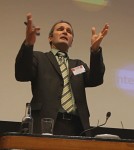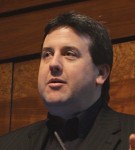The London Loudness Summit 2011
Graham Heath MIPS reports on a specialist one-day summit held in London in December 2011
“Loudness refers to the perceived strength of a piece of audio (music, speech, sound effects etc.). The loudness depends on the level, frequency, content, and the duration of the audio, amongst other things” (On the way to Loudness Nirvana –Audio Levelling with EBU R128: Florian Camerer ORF)
I was asked by IPS Chairman Simon Bishop MIPS to write a short article about the recent loudness summit I attended just before Christmas 2011. I agreed with some trepidation, as writing for the IPS website is quite daunting! I feel a bit like a WW2 bomber pilot worried about flack and being shot down in flames! So what is all this loudness malarkey about? As a TV Sound Supervisor I try to tickle PPM6s on the meters and, hopefully, make a decent enough balance that’ll earn me my next crust. However, I’m constantly frustrated by the ‘loudness’ of network junctions, adverts, and even VT packages that are often unheard until the dress run (if you’re lucky enough to get a dress!), and sometimes not even then. Yes, I could slam my audio hard into a compressor or limiter – and I have tried multi-band compressors in the past – but I don’t like the results and, more to the point, why should I? I am there to make the audio pleasing to the customer and, just as importantly, to the listener at home. I don’t know anyone who hasn’t at some time had to ride the volume control when watching the TV for any length of time because of unwanted changes in loudness. There are lots of complaints about audio from the public, some justified and some ill informed, but it appears that the loudness issue is a problem faced by all broadcasters worldwide, and one that needs regulation. So what exactly is being done about it? Well lots, actually. I knew there was talk amongst my colleagues about EBU moves to measure and control loudness but I didn’t realise quite how global an issue it had become and how my working practises face change over the next few years. Indeed France and Holland have already introduced loudness compliance quite successfully, as I believe have Japan and some major networks in the USA . When I became aware of the London Loudness Summit I was quite prepared to pay for a ticket when, by chance, I saw a post on the IBSnet (now IPSnet) about a draw for free tickets – so I entered and won! What’s the chance of that? (I must do the lottery). So on the 16th of December I made my way to the conference which was being held in the charming and imposing building of the Royal Institute of British Architects at Portland Place.  The summit was attended by about eighty engineers, manufacturers and broadcasters and the opening address was from the summit chairman Florian Camerer MIPS (at left) who is one of the top broadcast sound engineers at ORF, with a huge knowledge and understanding of all aspects of audio. He is to sound what Steven Fry is to the English language! Florian spoke eloquently about EBU R128, PLOUD [pronounced P-Loud – Ed], LUFS, Compliance, Dynamics in mixing (or the lack of it), and Gating… and I began to feel like I needed to do a bit of homework. Luckily the EBU maintains a fantastic web site that helps to explain all of these terms: http://tech.ebu.ch/loudness
The summit was attended by about eighty engineers, manufacturers and broadcasters and the opening address was from the summit chairman Florian Camerer MIPS (at left) who is one of the top broadcast sound engineers at ORF, with a huge knowledge and understanding of all aspects of audio. He is to sound what Steven Fry is to the English language! Florian spoke eloquently about EBU R128, PLOUD [pronounced P-Loud – Ed], LUFS, Compliance, Dynamics in mixing (or the lack of it), and Gating… and I began to feel like I needed to do a bit of homework. Luckily the EBU maintains a fantastic web site that helps to explain all of these terms: http://tech.ebu.ch/loudness
EBU Loudness
So before I give a brief synopsis of the summit I suppose I should try and summarise, in the smallest of nutshells, what the EBU is specifying regarding loudness. I would like to add that the following few paragraphs are a condensation mainly of Florian’s EBU article: On the way to Loudness Nirvana [available at: http://tech.ebu.ch/docs/techreview/trev_2010-Q3_loudness_Camerer.pdf], for which I’m hoping that he (and you) will forgive any inaccuracies. EBU R128 and its four accompanying technical documents were published in August 2010 after two years of intensive work by the EBU PLOUD group led by Florian, proposing a set of standards/recommendations regarding metering, production values, and programme distribution for radio as well as TV. Florian’s article describes the fundamental changes that we must embrace over the coming years in broadcast audio to control programme loudness. Programme Loudness is defined as the “integrated loudness over the duration of a programme”, and in addition to monitoring and controlling this we will also have to take into account the Loudness Range (LRA) and the Maximum True Peak Level. The former is the distribution of loudness levels within a programme and is useful in deciding if the use of dynamic compression is required. The latter is the “maximum value of the [reconstructed] audio signal waveform of a programme in the continuous time domain” measured with oversampling peak meters conforming to the new ITU and EBU specifications to reveal any potential peak clipping between samples which wouldn’t be seen on other meters, especially PPMs. The maximum allowable broadcast True Peak level has been defined as -1dBTP for generic linear audio.
Florian advocates maintaining appropriate use of dynamic range coupled with good mixing practises within a programme, but the loudness normalisation should ensure better consistency between programmes, adverts and networks. Indeed, he argues that quality should improve by implementing the loudness normalisation specifications as the current perceived benefit of producing the loudest soundtrack (especially amongst advertisers) disappears and that there will be less level-compression artefacts. Traditionally we have used PPMs in the UK broadcasting industry, but their finite integration time means that they (deliberately) don’t take into account brief transient peaks. These transients can be problematic, especially on (still used) FM transmission carriers, which is why there is a Permitted Maximum Level (PML) of -9dBFS (to ensure adequate headroom). However by crafty processing and transient clipping (the human ear tends to ignore transient clipping of less than around 5ms), which is deemed acceptable by some commercial organisations, the loudness level of an audio signal can be significantly increased by around 4 to 5dB whilst keeping the PML at the allowed value,– and hence the need at home to ride the TV volume control. The International Telecommunication Union (ITU) formulated a standard which forms the basis to counteract this kind of practice, which was published as: ITU-R BS.1770. This describes algorithms to measure both loudness and true peak levels. The ‘K weighted filter curve’ is a modified second-order high-pass filter (K is just an arbitrary letter and has no special meaning) which is applied to all channels (except the LFE channel in surround sound programmes) and the results, after a clever bit of maths, give a figure of ‘LKFS’ (Loudness, K-weighted, referenced to digital Full Scale). In R 128, this was subsequently renamed ‘LUFS’ as the EBU’s preferred term (Loudness Units referenced to digital Full Scale). In short, -23 LUFS is the ‘Nirvana’ to which we should aim.
The average programme loudness is measured with a loudness meter compliant with the EBU metering standard ‘EBU Mode’, and which incorporates a defined gate function. This gate pauses the loudness measurement when the audio level falls below a specified threshold for a minimum duration so that periods of silence or low level atmospheric effects don’t reduce the programme loudness figure inappropriately. By normalising source material to the -23 LUFS standard level there is an inherent simplicity in the process and we can mix in a more dynamic way and hopefully achieve better quality mixes. It is also possible to manipulate any associated programme metadata so that the loudness normalisation can be achieved at the consumers’ end – and to help get your head around this concept I really recommend that you visit the EBU site and read Florian’s article and the ‘Practical Guidelines’ (EBU Tech Doc 3343) several times!
Summit Else
Well back to the summit. After Florian’s opening address we heard from Randy Conrod who is the product manager for Digital Products at Harris USA. Randy gave a talk on topics such as why loudness is a collision of biology and technology, and how metadata could be the panacea but isn’t due to its susceptibility to tampering.  Next we heard from Phil Greene (right), the lead technologist for Technology Division BBC, and Tim Carroll, President and Founder of Linear Acoustic. One of the notable points that Phil made is that there is a dilution of audio skills within a diminishing work force. Very few people are being trained properly today and this has an effect on standards as fewer people understand the underlying principles. He told us that the majority of loudness complaints received by the BBC were age-related (very few, if any, young people complain about audio quality) and that we as an industry should be focussing more on loudness and intelligibility. To be fair the EBU already is, even if the UK hasn’t as much up until now. He also reiterated Florian’s point about bringing audio quality back into focus.
Next we heard from Phil Greene (right), the lead technologist for Technology Division BBC, and Tim Carroll, President and Founder of Linear Acoustic. One of the notable points that Phil made is that there is a dilution of audio skills within a diminishing work force. Very few people are being trained properly today and this has an effect on standards as fewer people understand the underlying principles. He told us that the majority of loudness complaints received by the BBC were age-related (very few, if any, young people complain about audio quality) and that we as an industry should be focussing more on loudness and intelligibility. To be fair the EBU already is, even if the UK hasn’t as much up until now. He also reiterated Florian’s point about bringing audio quality back into focus.  Tim Carroll (right) was a joy to listen to as he imparted knowledge with good humour. He touched on the metadata issue in some depth, suggesting that current metadata systems needed drastic streamlining (apparently there are 240 parameters in the Dolby Digital system), as well as finding a means to safeguard metadata against tampering. His main mantra was that ‘a happy consumer equals compliance, and happy producers equal unmodified audio’. To achieve this we should have an accurate delivery specification which is accessible by everyone and which matches average loudness by verifying content and the correct use of metadata.
Tim Carroll (right) was a joy to listen to as he imparted knowledge with good humour. He touched on the metadata issue in some depth, suggesting that current metadata systems needed drastic streamlining (apparently there are 240 parameters in the Dolby Digital system), as well as finding a means to safeguard metadata against tampering. His main mantra was that ‘a happy consumer equals compliance, and happy producers equal unmodified audio’. To achieve this we should have an accurate delivery specification which is accessible by everyone and which matches average loudness by verifying content and the correct use of metadata.
He pointed out that it could still go horribly wrong of course, for example if a harrowing death scene in a dark drama is followed by an in-your-face shampoo advert – particularly where there may not be sufficient budget or an adequate system to oversee the content’s suitability beforehand! He also felt that (wide) dynamic range material will always generate complaints, despite loudness compliance because of the wide range of platforms that consumers use to listen/watch, from low-end TVs to high-quality home theatres, iPods and internet-based TV – each with their own inherent processing quirks and quality limitations. One interesting query he raised was how many under-30s with a hi-fi system do you know? I can’t think of any, and all the people I know with decent audio systems are soundies or musicians, which means young people are in danger of being less discerning about quality (if that hasn’t happened already) because of the devices they’re listening to and their lack of experience of what good-quality audio really is.
Florian then gave a brief summary and overview before lunch, giving more food for thought (groan… sorry!) by discussing some potential pitfalls of the K-weighting system and how unscrupulous broadcasters could abuse the system. For example, placing male voices in the LFE as well as the main channels allows the level to gain 1 or 2 LUFS for ‘free’ because the LFE contribution is unmetered (although this wouldn’t work with Joe Pasquale, of course!). Another example he cited was fooling the Gating threshold with the right level of background music or atmospheres.
Finally, whilst -23 LUFS is the target Florian restated the importance of using your ears and balancing skills, and that there is no need to compress the audio into an ‘audio sausage’ (Florian’s term for a squashed waveform).
After lunch we heard from Jeffrey Riedmiller, Director of the Sound Platform Group at Dolby Laboratories Inc. Topics touched on were measurement and control in the professional space, and rendering and control of loudness metadata in end-user devices. We also saw a video of Barrack Obama signing legislation that makes it a US legal requirement to have loudness processing in the broadcast audio signal chain. Failure to comply will result in a fine of 2% of revenue which, for some broadcasters, could exceed $100 million. Generally, the larger broadcasters will regulate loudness properly but there are many regional TV and radio stations that will probably just plug a processor at the end of the chain regardless of whether there is loudness control already in place elsewhere. In an ideal world metadata would turn this off when necessary, but then it could also be bypassed deliberately to safeguard the broadcasters’ interests. Jeff also pointed out that by implementing loudness management through the process of law it becomes very difficult to amend or update the compliance standards, and could become counterproductive.
Other speakers at the summit included Peter Poers of Junger Audio and Chris Hollebone of Merging Technologies, They put forward very articulate and salient information which expanded and reinforced the points made throughout the summit and summarised above. Last but not least came Richard Van Everdingen, a broadcast sound consultant specialising in Loudness Nornalisation. He talked about the importance of maintaining loudness control and normalisation procedures throughout the whole signal chain, discussing programme distribution issues all the way to the consumers’ set-top boxes. Completing the day’s presentations, Matthieu Parmentier from France Télévisions surprised us all with the well thought out strategy being implemented in his organisation where loudness normalisation is now the norm (as of January 1st, 2012) with mandatory compliance of all programming by the end of the year!
Q & A
The summit concluded with a Q&A session involving all of the day’s speakers, after which it was time to return home with my goody bag, and a visit to the EBU web site to help clarify and focus my understanding of many of the topics and issues raised. Going into this summit I really didn’t know what to expect, but it was a welcome eye opener and forced me to do some homework. The loudness normalisation issue isn’t as scary as it might seem. It means some changes to our current metering tools and techniques, and to the required delivery standards, but for the majority of us we will continue to work much as usual and still balance, dub, edit, and acquire audio in much the same way, and we will still rely on the best monitors possible: our ears. It might, however, bring audio to the forefront of production values… though I wouldn’t hold my breath!
I found the following documents invaluable in helping me understand the EBU standards and recommendations, and to write this article, and strongly recommend them for some background reading.
| EBU R 128 | Loudness Recommendation |
| EBU Tech 3341 | Metering specification |
| EBU Tech 3342 | Loudness Range descriptor |
| EBU Tech 3343 | Practical Guidelines |
| EBU Tech 3344 | Distribution Guidelines |
| On the way to Loudness Nirvana | Florian Camerer ORF |
Links to all these papers can be found at: http://tech.ebu.ch/loudness
Graham Heath


